Your front yard sets the tone for your home. It tells the whole neighborhood a little about who you are. The problem comes when you want to make a statement but really need to conform to the standards set by your neighbors or a Homeowners’ Association.
The safest choices for your front yard use mulch and rocks. We’ve put together a list of front yard landscaping ideas with rocks and mulch.
Why rocks and mulch? Covering part of your lawn with low-maintenance plants will save you time and lower your water bill.
As mulch decays, it releases nutrients into the soil, saving you from fertilizing. It protects dormant plants in the winter and it reduces soil erosion. Over time, mulch will compact the soil, making your plants standout.
Use rocks for decoration, to set boundaries, and create decorative vignettes. Using more rocks means less grass to mow and water. We’re all looking for ways to cut back on our water usage. Rock gardens can help you with that.
We’ll show you how rocks and mulch can look great in front yards.
You’ll discover how others keep their neighbors from trampling a corner lot and how holding the soil in place eliminates mowing on a hill. You’ll find ideas you can use, whether you live in a dry or cold climate.
1. Transform Your Backyard with Natural Boulders and Rocks
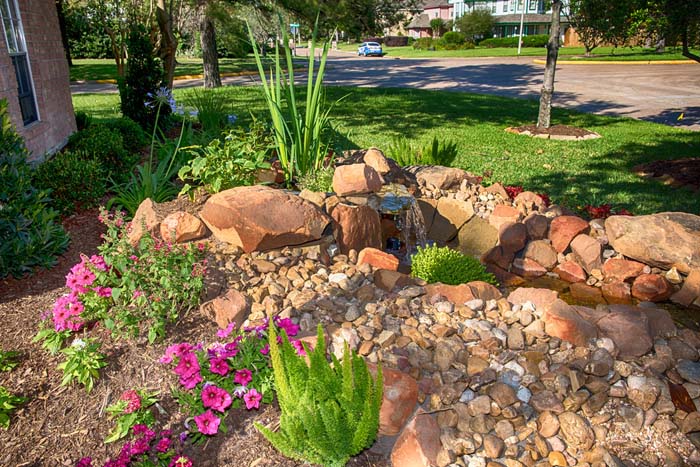
Create a natural sculptural landscape with large rocks and boulders.
Easily create a bubbling brook with a water pump return system.
2. Instantly Boost Your Curb Appeal with a Mulch Raised Bed
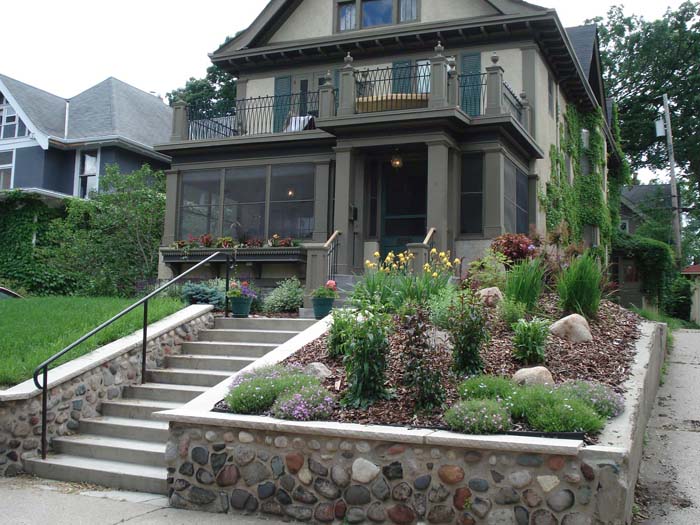
Build up a mulch bed with slow growing shrubs and ornamental grasses.
The homeowners chose a conventional lawn on the side that adjoins their neighbor’s lot. This expands the look of both lots.
via Beds and Borders Landscape
3. Create a Beautiful Contrast with Mulch and Pavers
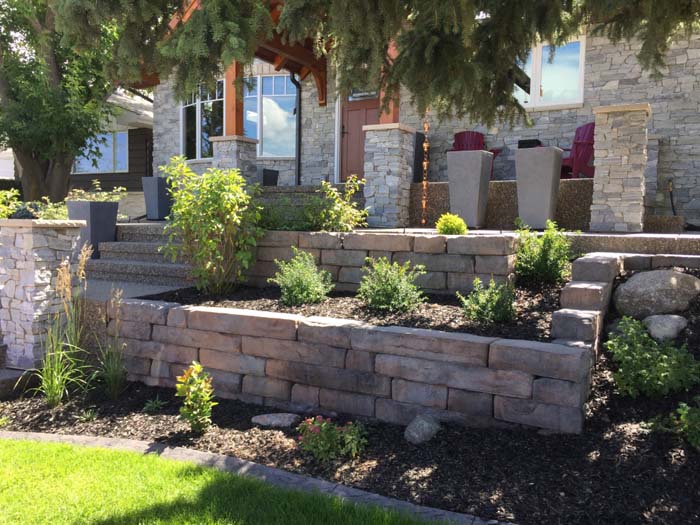
You can mix retaining wall beds with a ground-level bed by matching the edging pavers with the bricks of the retaining wall.
Choose low-growing shrubs for the middle tiers and flowering plants on the bottom.
via Twisted Rock
4. Add Interest to Your Landscape with a Rock Bed and Mulch
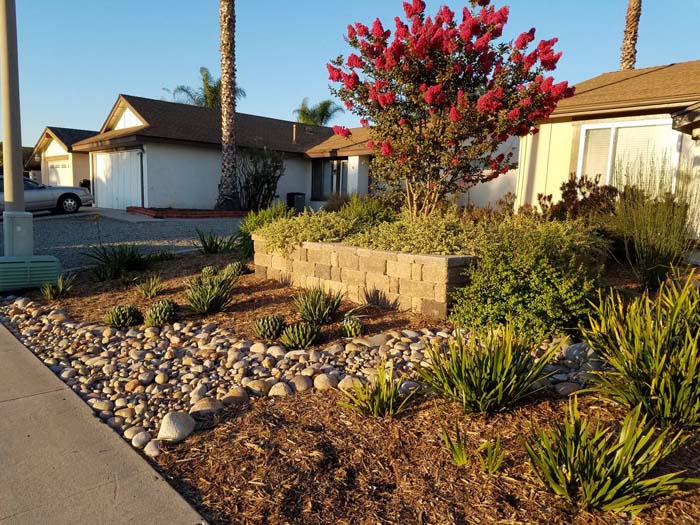
Add interest to a yard of mulch by adding a rock bed.
The size of the rocks should be larger than pea gravel to discourage foot traffic.
via Ornamental Gardens by Lisa
5. Beautify Your Pathways with Crushed Gravel
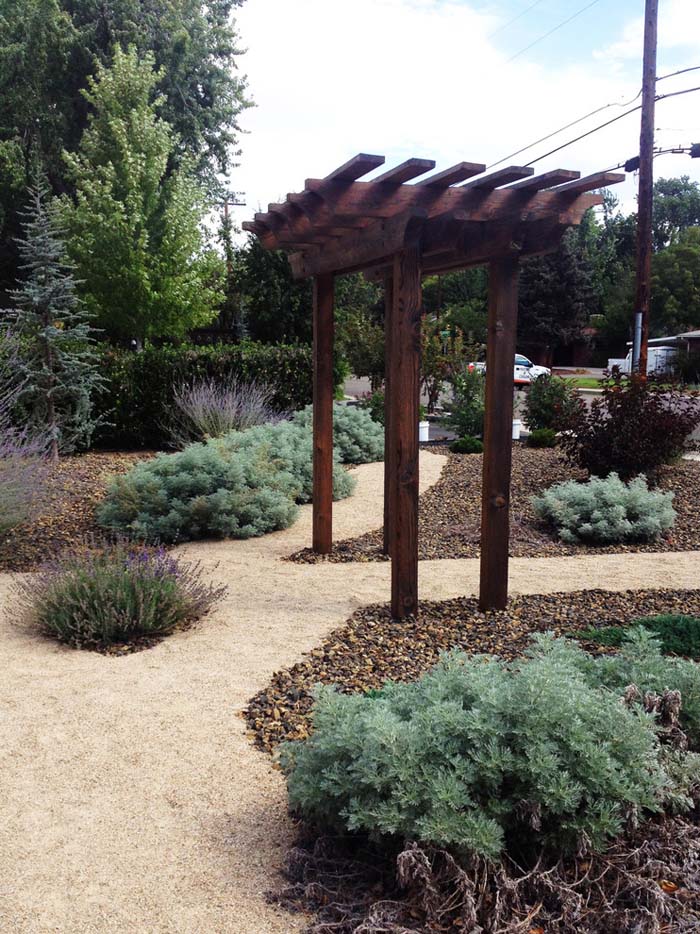
When you want to create paths in your yard, use crushed gravel.
28 Beautiful Front Yard Landscaping Ideas With Rocks and Mulch video:
Light colors help distinguish the path from the mulch beds.
via Stack Rock Group
6. Make an Artistic Statement with Rock Patterns
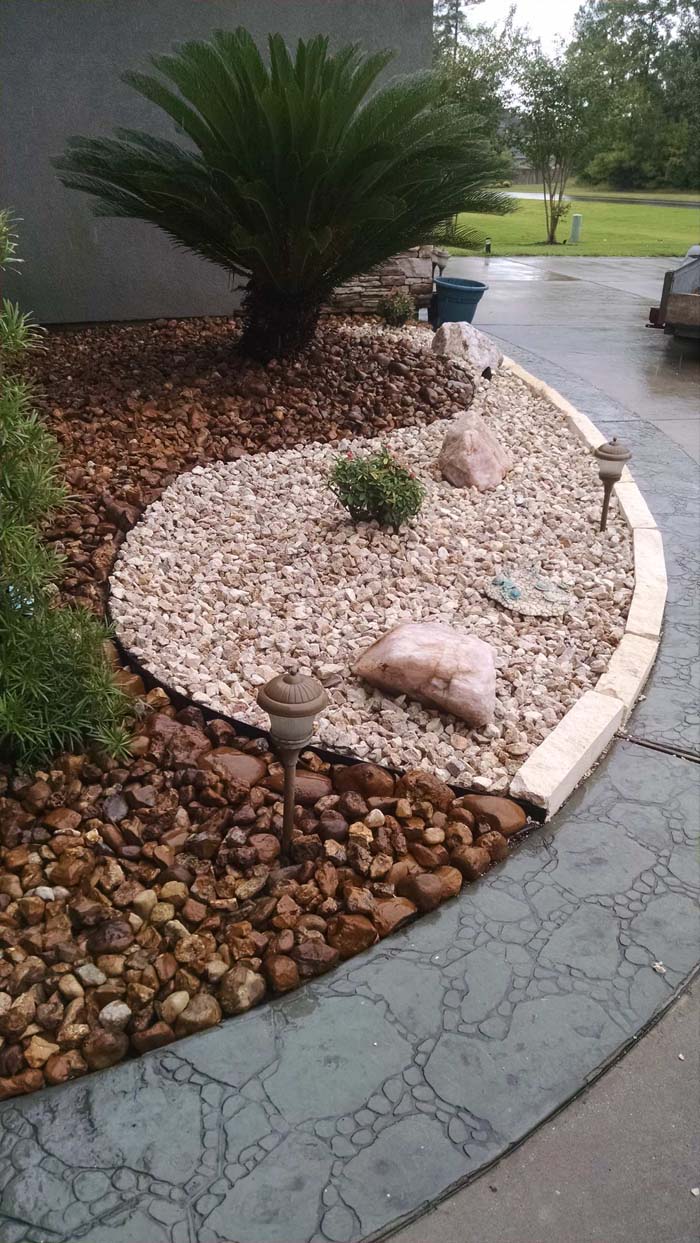
Wavy patterns are a natural solution to a curved lot. Larger brown rocks and smaller beige gravel are used as a contrast in color and texture.
Recreate the look of the edging with quick setting cement and a cement pigment. Use a metal edge to set the form in place.
via Optimistic Landscaping
7. Keep Lawn and Garden Neat with Concrete Edging and Mulch
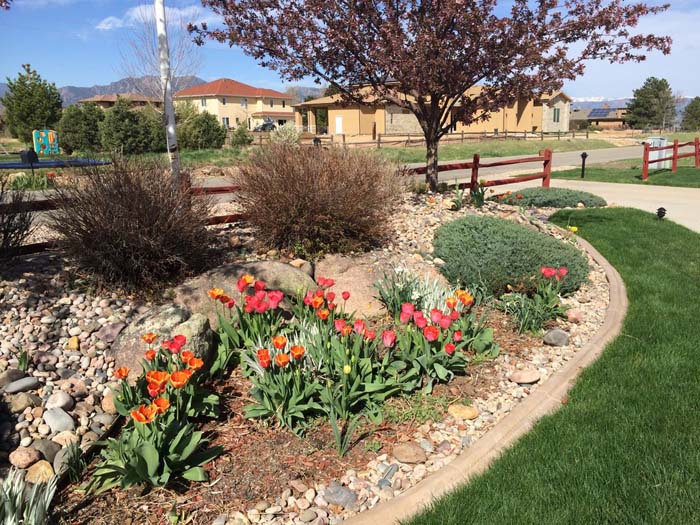
Small gardens are an opportunity to add color and personality to a yard. If you’d like to create privacy, taller shrubs are the answer.
This little garden uses poured concrete for its edging. This keeps the smaller rocks from landing on the manicured lawn.
via Rush Management
8. Turn Sloping Yard into a Chic Landscape with Mulch and Rocks
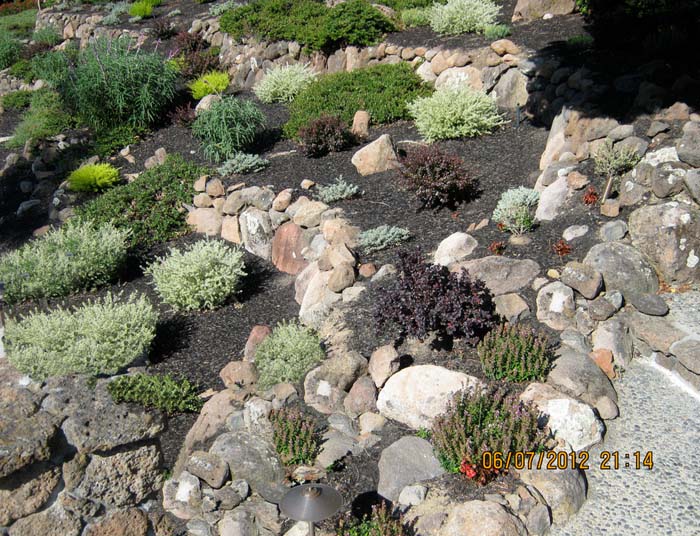
Mulch keeps the weeds at bay and is a nice contrast to ground cover.
9. Beautify Your Yard with Flagstones Garden Walkway and Mulch
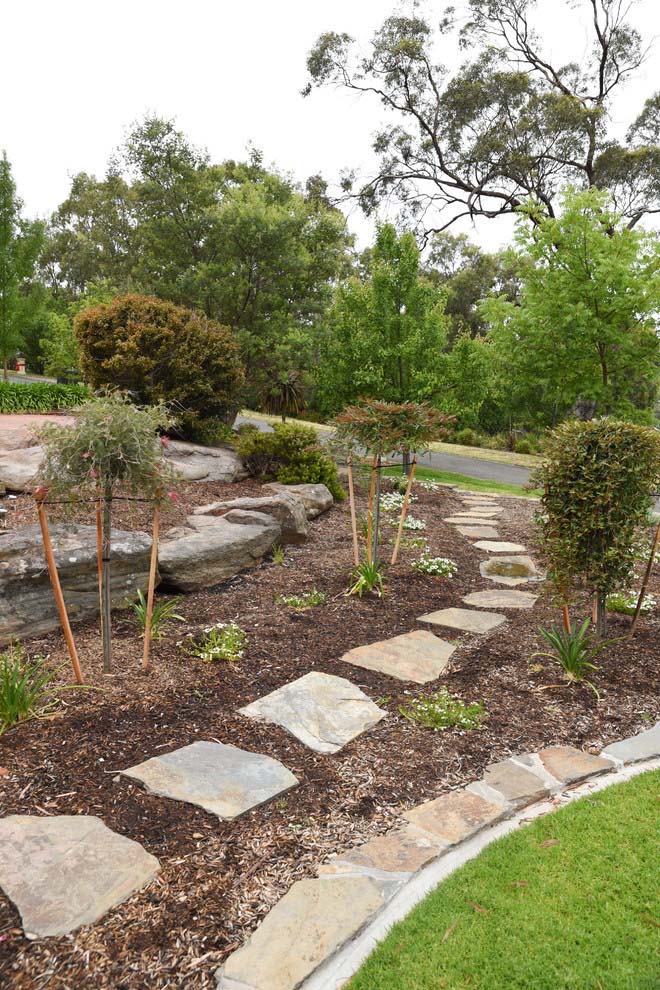
If you live on a corner lot with a lot of foot traffic, create a pleasant corner walkway for your neighbors.
Mulch can be used in place of pea gravel or grass to add a path through your yard. Flagstone is an organic and inviting choice.
10. Welcome Guests with Stylish Large Stepping Stones
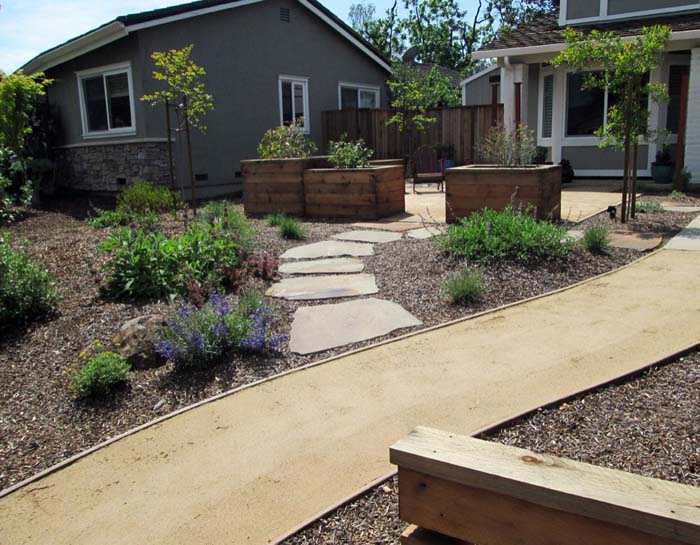
Larger stepping stones give visitors a huge welcome to your home.
The stones here don’t lead to the front door. Instead, they lead to a patio.
via Taproot Gardens
11. Upgrade Your Flagstone Pathway with Crushed Gravel
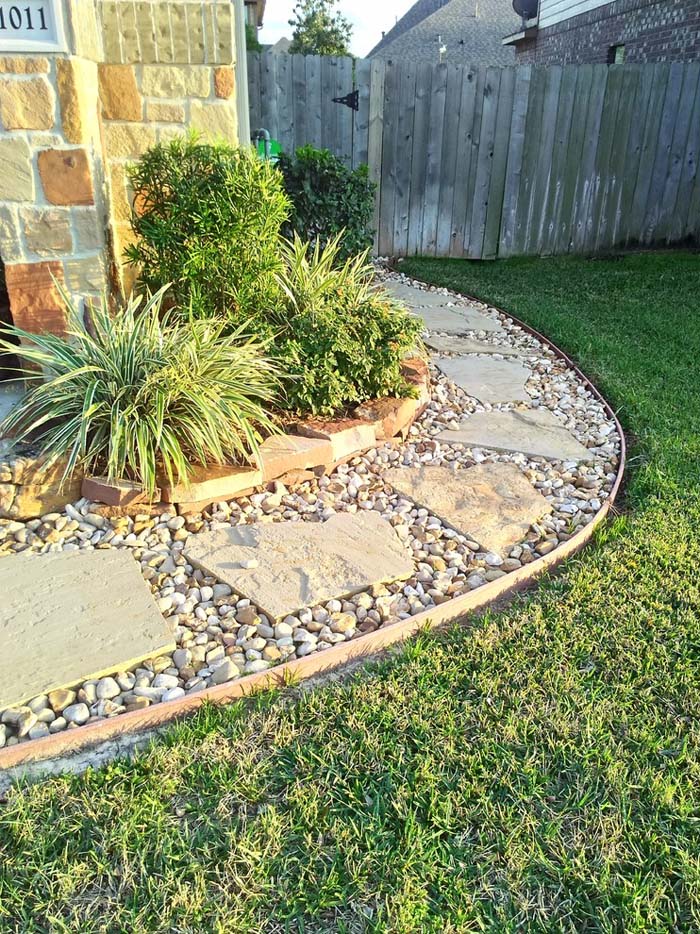
The perfect place to create a path is where your lawn is already worn down by foot traffic. Most people will experience this from their driveway around to a back gate.
Flagstone on top of crushed gravel is an easy do-it-yourself project.
via Optimistic Landscaping
12. Design Your Yard For Maximum Erosion Protection
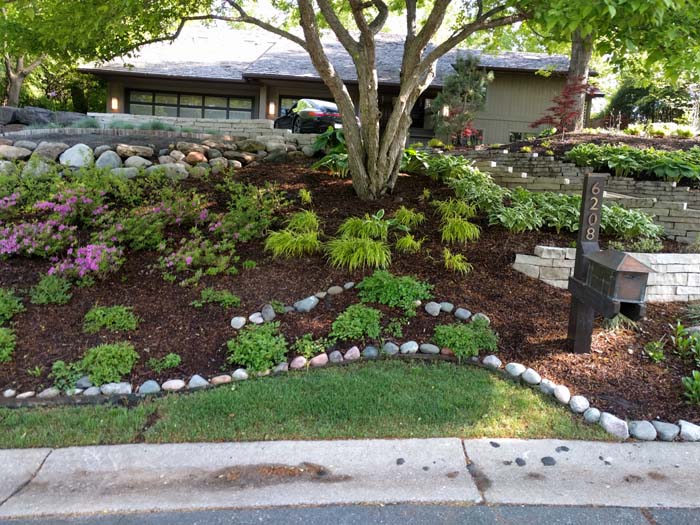
This yard design uses larger rocks as edging. This lessens erosion on the hill. A small patch of grass keeps the mulch from sliding onto the sidewalk.
Care was taken to keep the mailbox accessible while setting it far enough away from the walk to prevent damage from plows or errant drivers.
via Beds and Borders Landscape
13. Use a Raised Rock Bed for a Small Garden Under a Tree
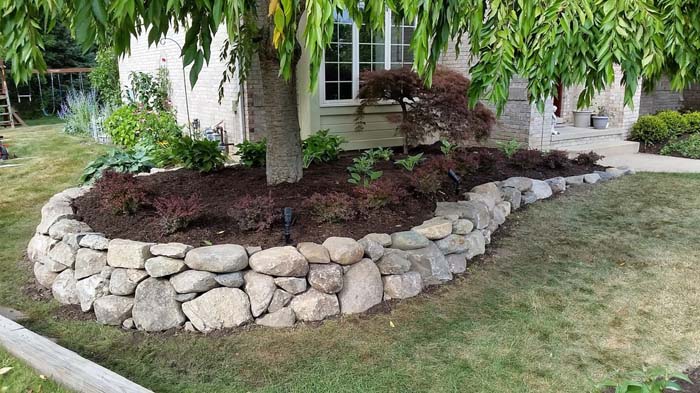
It can be difficult to do landscaping around the roots of a large tree. You could add a fast-growing plant like a Hosta. Another idea is to build a raised bed around the base.
Use large white rocks for a casual look. Use precast bricks for a formal garden.
via Poseidon Ponds
14. Add Definition with Ornamental Grass and Large Rocks
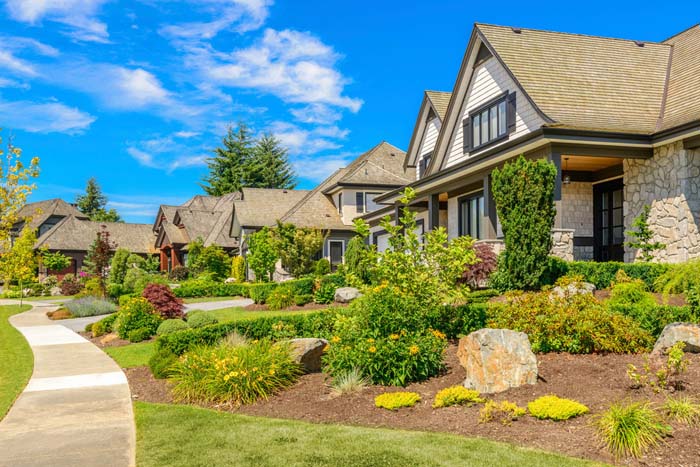
Add natural sculptures in your yard with large stones and small boulders. Soften the overall look of your yard by planting ornamental grasses near the stones.
There are grasses that will work with almost any growing zone.
via MAC Land Works
15. Easily Install a Modern Raised Garden Bed
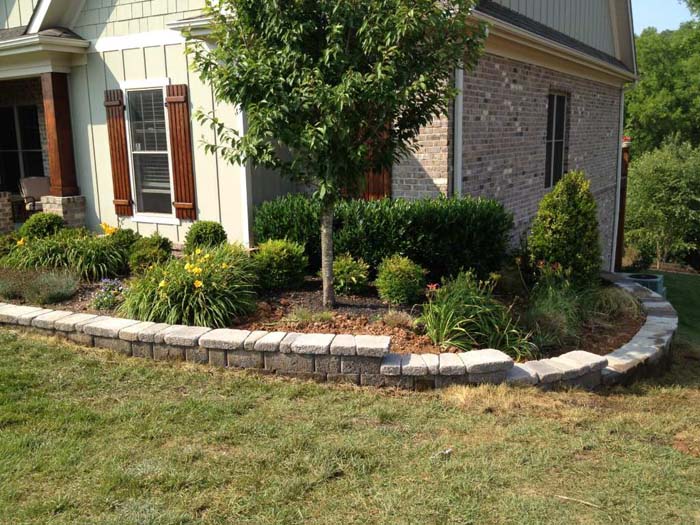
Build a raised garden bed to ease a sharp drop off near the foundation of your home.
Hedges will eventually fill out the back. Perennials only need to be planted once and with very little care, will grow back every year.
via Wadescapes
16. Meticulously Place Boulders Across Your Front yard
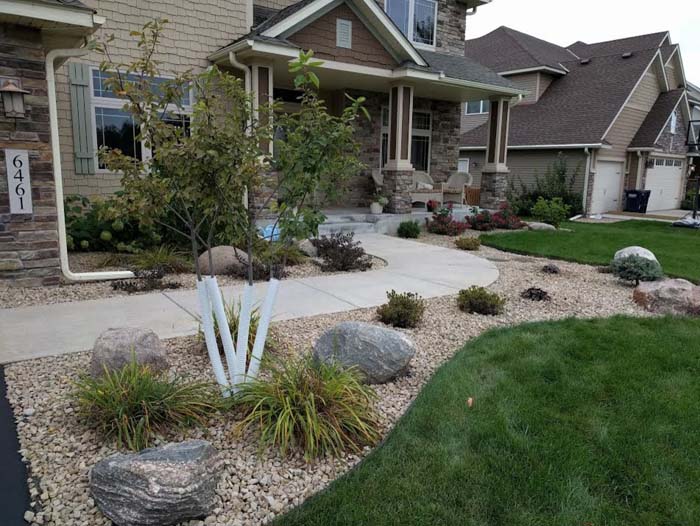
When designing your landscape, consider scale. Choose boulders over smaller stones when you have a larger house and yard.
You’ll have a garden that isn’t dwarfed by the size of the home, and larger rocks mean you’ll need fewer to make an impact.
via Beds and Borders Landscape
17. Achieve Monumental Beauty with Dry River Bed Rock Garden
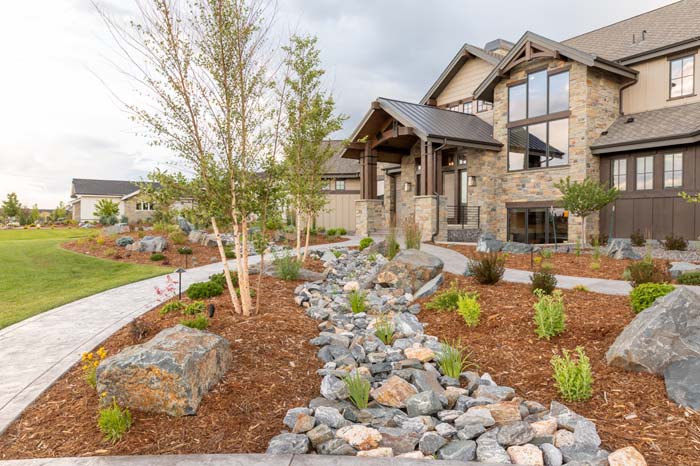
A dried river bed is one of the easiest ways to start a rock garden. Pick rocks that are all similar in size and a color that contrasts with the surrounding garden. These light gray and brown rocks stand out because of their size and color against the mulch.
The larger rocks are similar to the riverbed rocks. This sells the idea that this is all along the same area of the forest.
via Deep Seeded Landscape and Design
18. Enhance a Rock and Mulch Garden with Seasonal Perennials
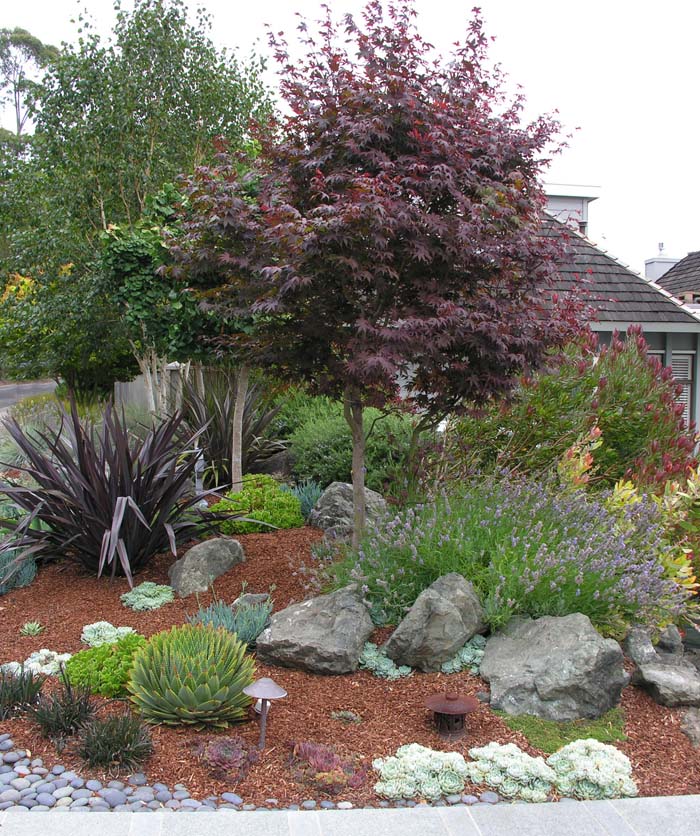
Dry climates are the perfect place to create a mulch and rock garden.
You don’t have to move large boulders, just build around them. If you’re living in a dry climate, add slow-growing succulents like ornamental thyme, Parry’s agave, hens and chicks, and Zwartkop.
via Leigh Designs
19. Make Visual Boundary for a Lawn with Enhanced Landscaping
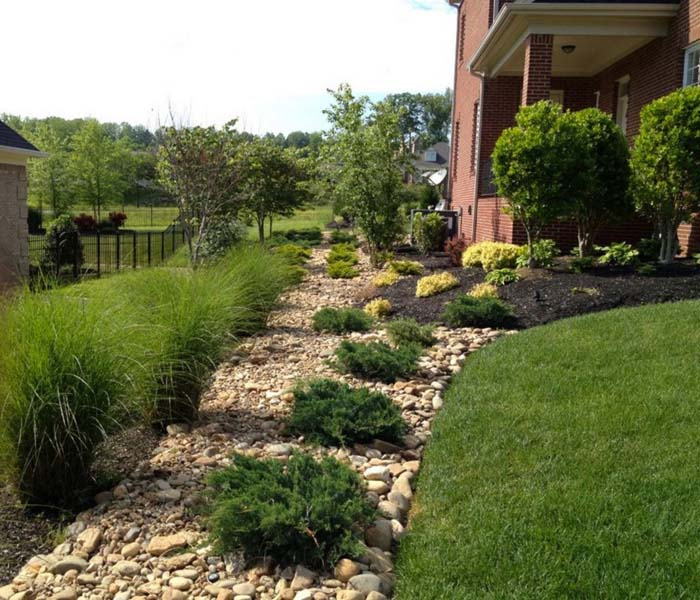
A dried river bed doesn’t have to intersect your lawn. Add small rocks to a channel on the side of your home. There’s a significant drop-off at the edge of the property.
A layer of dirt was added along the edge and ornamental grasses were planted to minimize erosion. Next to that, the long, dried riverbed has some low-growing dwarf juniper “floating” on it.
The point here is to create a visual boundary where the lawn ends. This keeps grass cuttings on the property and avoids the hassle of negotiating to the drop-off.
via Wadescapes
20. Keep your Hillside Landscaping Secure with a Mulch Base
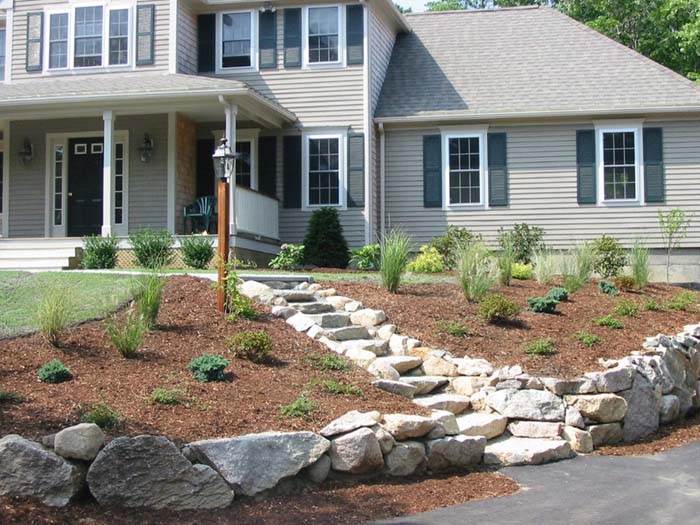
Use mulch when you are landscaping on a hill. It reduces soil erosion and when it decomposes, it will enrich the soil.
This yard was landscaped with the future in mind. The stone stairs are built with a low retaining wall along its sides. Eventually, the mulch will compact the soil enough that the ground cover will be all that’s needed to keep the soil intact.
via Briggs Landscape
21. Adjunct a Yard with Low-Maintenance Flagstones and Mulch
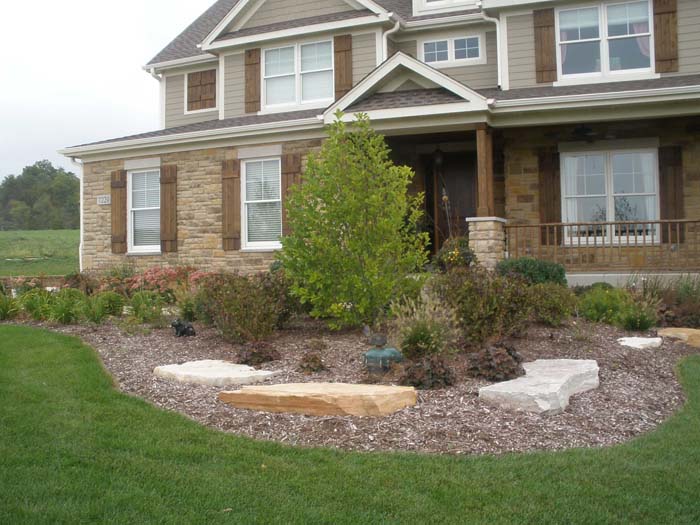
Setting up large flagstones around the outer portion of this garden bed will hold the mulch in place.
A dwarf tree is a low-maintenance idea that will add height to this garden bed.
via Yorkville Hill Landscape
22. Mulch and Shrubs Combo for a Lush and Vibrant Look
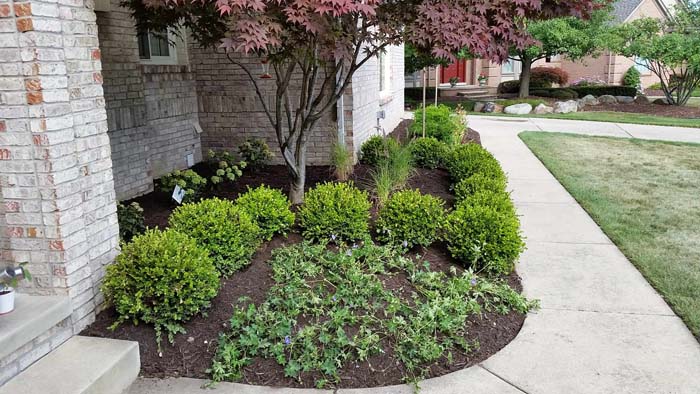
Gardens don’t have to be complicated. Shrubs and groundcover will thrive most anywhere.
Mulch enriches the soil. A dwarf tree such as a Japanese maple can fill out the corners.
via Poseidon Ponds
23. Avoid Soil Erosion with Large Flagstones
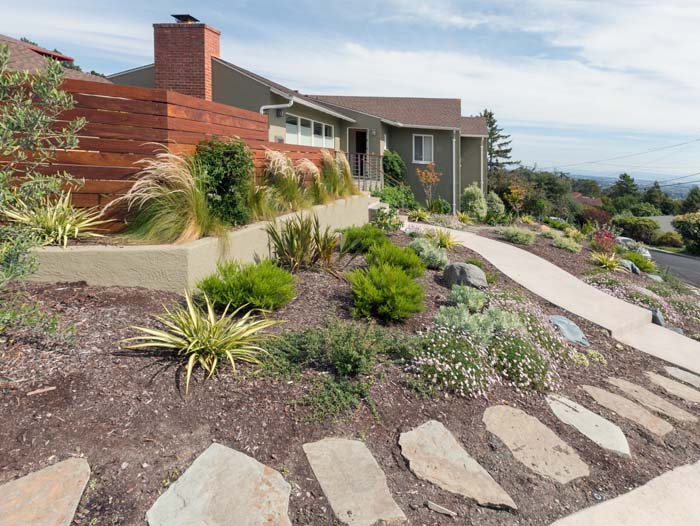
Here’s another solution for minimizing soil erosion. Instead of building a retaining wall, large flagstones were dropped into place at the base of the hill.
Mulch and ground cover work together to compact the soil.
via A Robbins
24. Guarantee Stability for Slopes with Large Rocks and Mulch
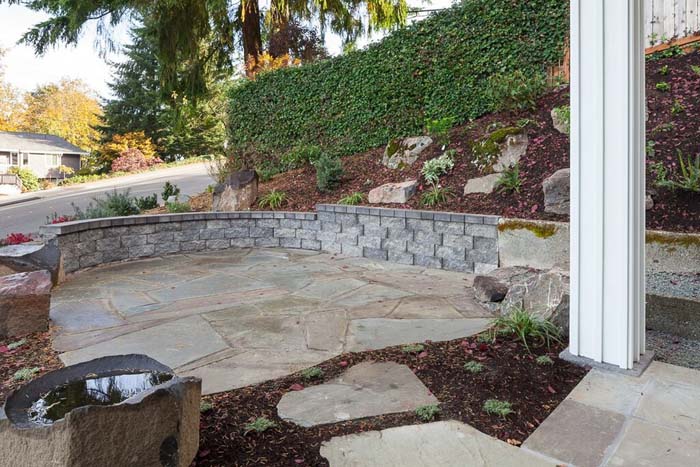
Another example of keeping the soil from eroding is this hill. A retaining wall was built with precast bricks. Large rocks added into the hillside compact the soil.
Using rocks that match the patio pavers ties the yard together.
via Urban Oasis
25. Border a Small Corner Garden with Rocks and Crushed Gravel
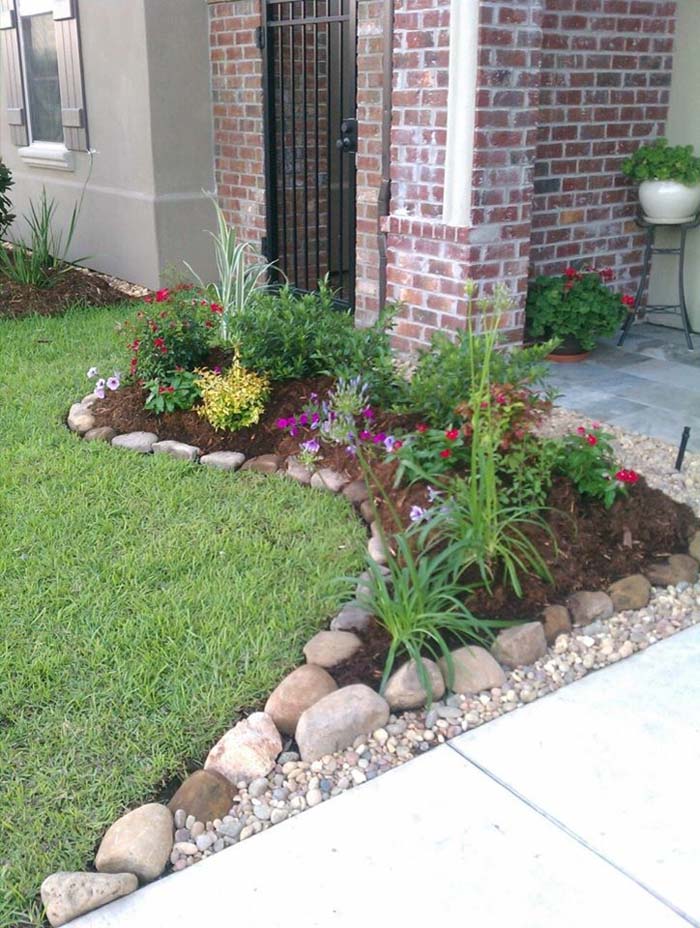
Smooth rocks and crushed gravel work together as edging in this flower bed.
If you want to add color with little maintenance, choose low-growing flowers like desert rose, Zagreb, or Dianthus.
via Beau Monde Landscape
26. Get a Contemporary Vibe with Square Rock Flower Beds
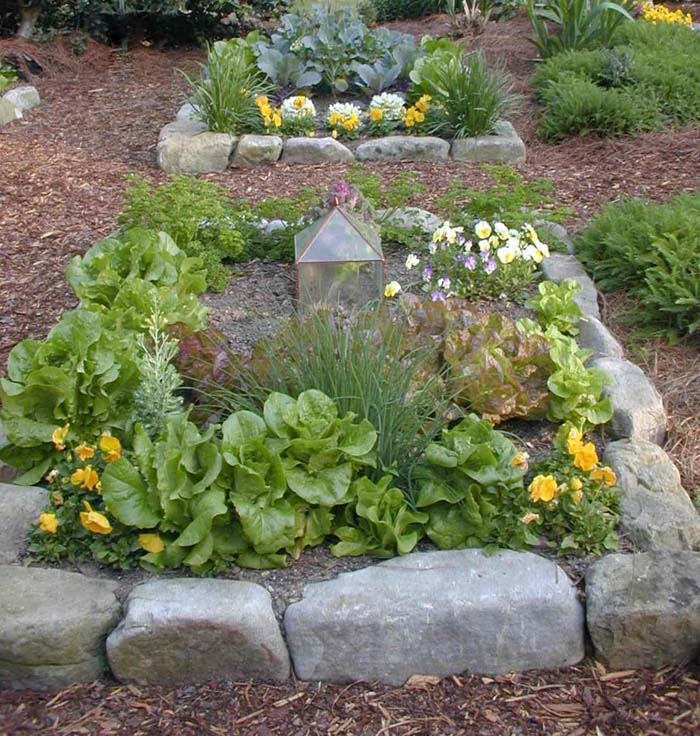
Flower beds can be broken up into several sections.
Separation gives you room to work, experiment with different plants, and is lower maintenance than filling the yard with plants.
via Home and Garden Design
27. Add Elegance and Sophistication with Pavers and Pebbles
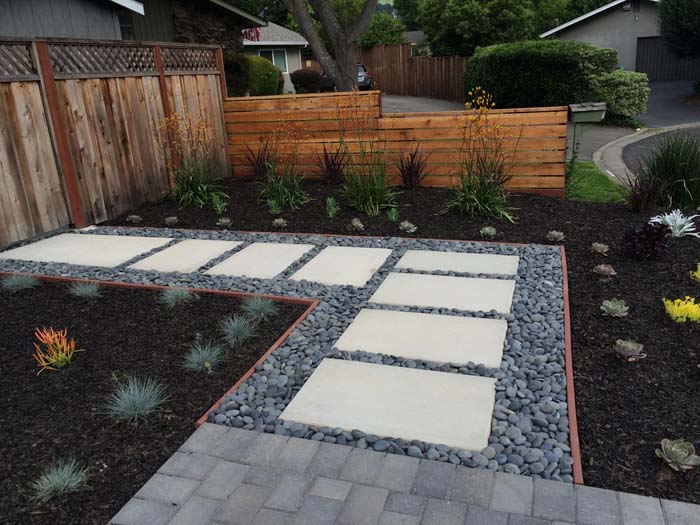
Today’s pavers can be made from natural stone or materials like porcelain.
Using only two colors in the walkway creates a minimalist look. The garden bed is dotted with succulents and flowering shrubs.
via DPG Pavers
28. Add Splendour to Your Home with Drought-Tolerant Plants
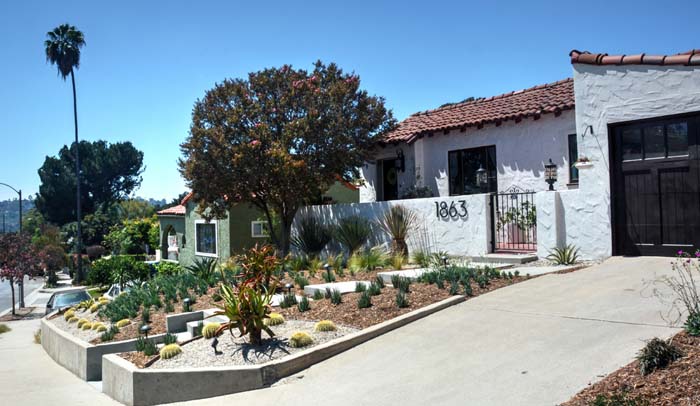
A grassy lawn may be impractical in your area. If that’s the case, decorate with succulents. Golden barrel cactus are popular for their no-fuss attitude.
If you’d like a tree, choose a semi-dwarf or smaller variety, such as Kidneywood. You can also trim a shrub like the Mexican Bird of Paradise into a tree.
via Red Berm





